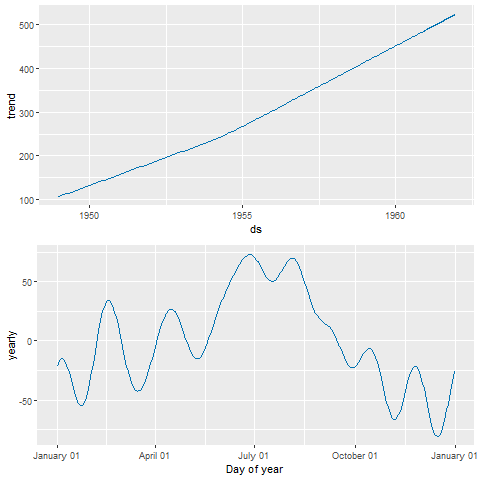Time Series Analysis using Facebook Prophet in R Programming
Last Updated :
22 Jul, 2020
Time Series Analysis is a way of analysing and learning the behaviour of datasets over a period. Moreover, it helps in learning the behavior of the dataset by plotting the time series object on the graph. In
R programming, it can be easily performed by using
ts() function that takes the data vector and converts it into time series object as specified in function parameters.
Facebook Prophet is a tool developed by Facebook for forecasting time series objects or data. It helps businesses to learn the behavior of their products by forecasting prices, sales, or weather.
Facebook Prophet tool is based on decomposable model i.e., trend, seasonality and holidays that helps in making more accurate predictive models with these constraints. It is much better than the ARIMA model as it helps in tuning and adjusting the input parameters.
Mathematical Equation of Prophet Model

where,
y(t) refers to the forecast
g(t) refers to the trend
s(t) refers to the seasonality
h(t) refers to the holidays for the forecast
e(t) refers to the error term while forecasting
Some Important Terms Used in Facebook Prophet Model
- Trend
A trend is a shift in development either in increment or decrement direction. Mathematically,

where,
C indicates the carry capacity
k indicates the growth
m indicates the offset parameter
- Seasonality
Seasonality is a feature of time series object that occurs at a particular time/season and changes the trend.
- Holidays
Holidays are a time period that changes a lot to the business. It can make a profit or loss depending upon the business.
Implementation in R
In the example below, let us download the dataset AirPassengers and perform the forecasting of the dataset using the Facebook Prophet model. After executing the whole code, the model will show the forecasted values with the trend and seasonality of the business.
Step 1: Installing the required library
install.packages("prophet")
|
Step 2: Load the required library
Step 3: Download the dataset AirPassengers from
here
ap <- read.csv("example_air_passengers.csv")
|
Step 4: Call the prophet function to fit the model
Step 5: Make predictions
future <- make_future_dataframe(m,
periods = 365)
cat("\nPredictions:\n")
tail(future)
|
Output:
Predictions:
ds
504 1961-11-26
505 1961-11-27
506 1961-11-28
507 1961-11-29
508 1961-11-30
509 1961-12-01
Step 6: Forecast data using predictions
forecast <- predict(m, future)
tail(forecast[c('ds', 'yhat',
'yhat_lower', 'yhat_upper')])
|
ds yhat yhat_lower yhat_upper
504 1961-11-26 497.2056 468.6301 525.7918
505 1961-11-27 496.0703 467.8579 525.6728
506 1961-11-28 493.1698 465.5788 522.9650
507 1961-11-29 496.0497 469.2889 524.6313
508 1961-11-30 492.8452 463.7279 520.4519
509 1961-12-01 493.6417 466.3496 522.9887
Step 7: Plot the forecast
png(file = "facebookprophetGFG.png")
plot(m, forecast)
dev.off()
|
Output:

Above graph shows the forecasted values of AirPassengers where,
Black dots refers to the original data,
Dark blue line refers to the predicted value(yhat), and
Light blue area indicates the yhat_upper and yhat_lower value.
Step 8: Plot the trend, weekly and yearly seasonality
png(file = "facebookprophettrendGFG.png")
prophet_plot_components(m, forecast)
dev.off()
|
Output:

The above graph shows the trend of the dataset that air passengers have been increased over a given period of time. In second graph, it shows seasonality of the dataset over a period of time i.e., yearly and signifies that air passengers were maximum between months from June to August.
Like Article
Suggest improvement
Share your thoughts in the comments
Please Login to comment...